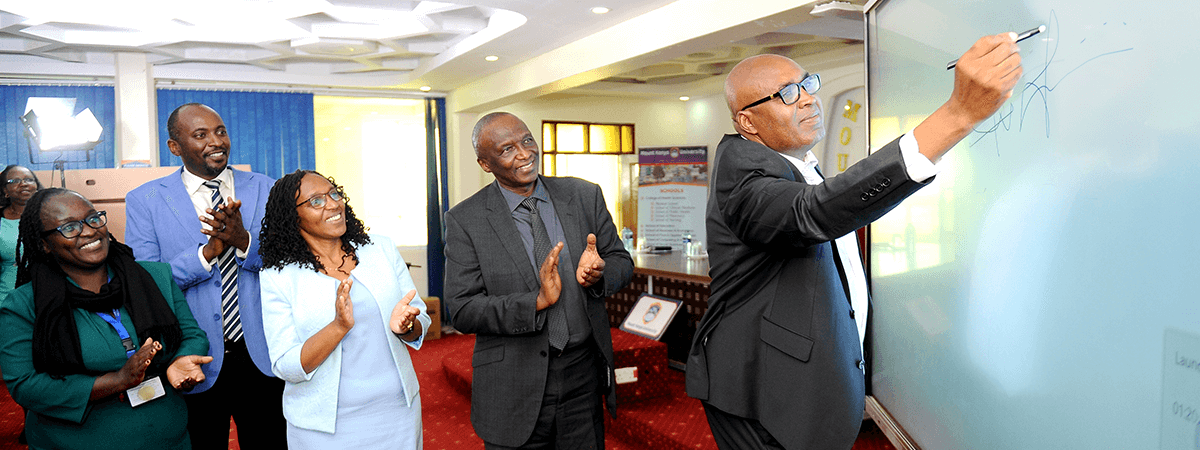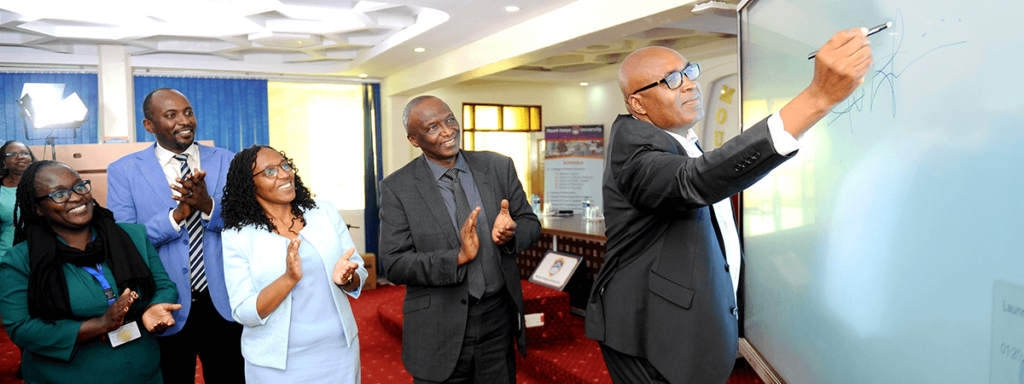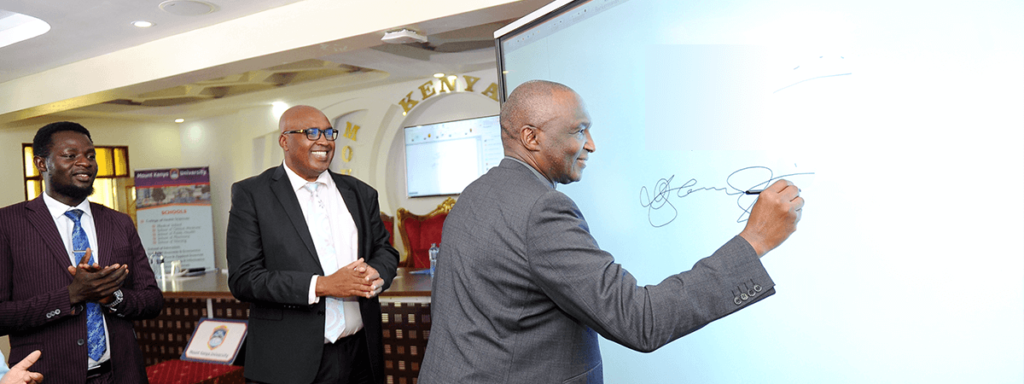
MKU acquires Interactive Displays to Enhance Technology in Teaching and Learning
In response to the growing demand for more engaging and collaborative learning environments, Mount Kenya University has integrated the use of Interactive displays and smart classrooms to enhance learning experiences and elevate the e-learning and conference experience. These interactive displays will serve as a dynamic platform for content delivery, fostering participation, and interactivity. The university intends to build Smart classrooms across the campuses and recording studios for content development.
This will complement earlier developments where the university began a journey of self-paced content development and digitization
Chairman, Board of Directors, Mount Kenya University, today handed over to the Vice-Chancellor newly acquired interactive displays that will be used to enhance lecturer-student interaction virtually. The 18 devices were acquired from China at a cost of KSh 28 million.

“These interactive displays will allow lecturers to incorporate a range of useful apps or teaching aids that support in simplifying different concepts in class, hence enabling lecturers to be more effective in training students virtually,” he added.
Prof Gicharu observed that the traditional model of “brick and mortar universities” would most likely be replaced by Open Universities that offer programmes through virtual platforms and retain only small administrative offices.
“As a University, we need to ensure that we are alive to where the world is going, embrace technological transformations, and integrate digital technologies with Artificial Intelligence (AI) and optimize on the positive contribution to improve livelihoods.
He maintained that the digital transformation agenda will be embraced in all Open and Distance Electronic Learning (ODEL) platforms and that MKU students will be among the first in the country to benefit from this technology.
“We expect that these interactive displays will be fully integrated in our training in Thika main campus and also in all our campuses and ODEL centers. We are fully committed to ensure that our students have the best learning experience,” the Chairman stated.
The Vice-Chancellor Prof Deogratius JAGANYI said it is high time for MKU to fully embrace the fourth industrial revolution by entrenching technology mediated modalities of teaching and learning in order to meet the needs and expectations of the current generation.

“MKU has already embraced digital transformation and we are well aware that pacing up growth in digital technologies will give us a competitive advantage in a turbulent and highly competitive higher education environment,” stated the VC.
He noted that the interactive Displays will support content delivery and enhance interaction between the students and their lecturers.
“I also note that the interactive displays will be useful in supporting collaborations, conferencing and presentations for postgraduate students hence promoting a vibrant research ecosystem in the University. All this will go a long way towards enhancing the transformative quality of teaching in e-learning and conferencing experiences at MKU,” Prof JAGANYI added.
The Deputy Vice-Chancellor, Academic and Research Affairs Dr Mercyline Kamande said the University has more than 12,000 registered students under Open, Distance and e-learning mode who will immensely benefit from the digital interactive displays.
The Key Features of the interactive displays include
- Dynamic Content Delivery
- Touch-sensitive displays thatIntegrate touch-sensitive technology to enable participants to interact directly with the content and provide tools for annotation, drawing, and manipulation of on-screen elements to encourage engagement.
- Collaborative Tools such as digital whiteboards, collaborative document editing, and real-time feedback. In addition, they enable seamless collaboration between participants, enhancing the overall learning and conference experience.
- Interactive Assessments, quizzes, polls, and surveys to gauge participant understanding and provide instant feedback and analytics to both educators and participants for performance improvement.
- User-Friendly Interface
- Accessibility and Inclusivity: The smart classroom technologies have accessibility features such as text-to-speech, screen readers, and adjustable font sizes. ensure that all students, including those with disabilities, can participate fully.
- Support for Remote Learning: With the rise of remote and hybrid learning models, interactive displays enable seamless transitions between in-person and remote lessons. Lecturers can conduct live classes with remote students participating via video conferencing, all while using the same interactive tools.
- Multimedia Presentations where lecturers/instructors can integrate multimedia elements such as audio clips, videos, and animations into their lessons. This multimedia approach caters to different learning styles and keeps students engaged.
- Virtual Field Trips: Virtual field trips enhance learning by providing immersive experiences without leaving the classroom.
- Visual Learning through Visual Aids and Real-time Annotations
- Access to Resources and Digital Libraries: Students can access digital libraries and e-books directly from the interactive displays. This expands their learning beyond traditional textbooks and encourages research skills
- Technology Integration: The Interactive displays support Microsoft Teams and other apps, which will make it easy to integrate with the existing e-learning platforms and conference systems in the university.












